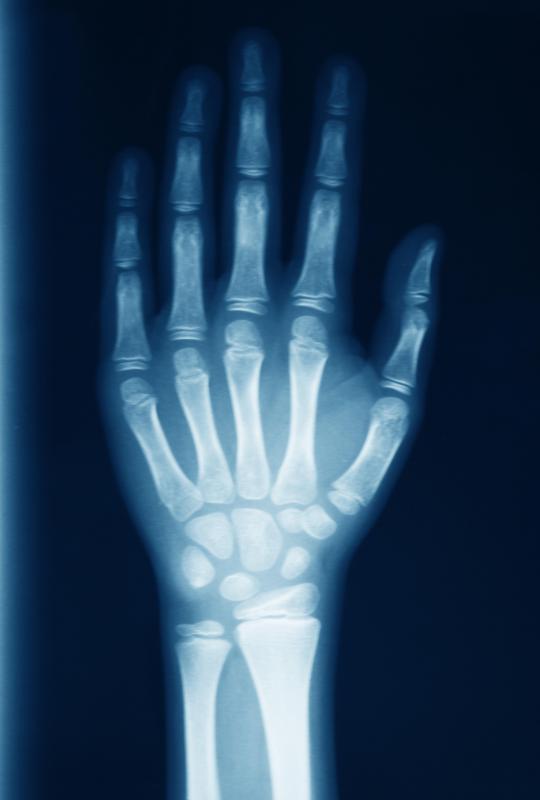At TheHealthBoard, we're committed to delivering accurate, trustworthy information. Our expert-authored content is rigorously fact-checked and sourced from credible authorities. Discover how we uphold the highest standards in providing you with reliable knowledge.
What Are Common Reasons for a Wrist MRI?
Medical professionals may request magnetic resonance imaging (MRI) of the wrist to evaluate patients with recent trauma, signs of joint instability, or a history of wrist disease. The indications for a wrist MRI can be quite variable. Concerns about tendon and nerve damage and lesions in the wrist are among the most common reasons to order this type of medical imaging study. Patients with questions about whether the procedure will be covered by insurance can request an approval letter in advance. Insurance companies will ask about why the doctor wants to order the test and can determine if it falls under their criteria for coverage.
When the wrist shows signs of carpal instability and injury, the doctor may request an imaging study to look at the soft tissues in the wrist. The wrist MRI provides excellent resolution and a thorough view. In some cases, it can eliminate the need for a more costly arthroscopy to look inside the risk for signs of ligament tears and other issues. This can make it a very useful diagnostic tool.

Another reason to ask for a wrist MRI is if abnormalities show up on other imaging studies, like x-ray or computed tomography (CT) scans. These may be ordered after trauma, such as a suspected fracture. If they show signs of a problem that is difficult to diagnose accurately, the doctor may request an MRI to get more detail. This additional information can be helpful for diagnostic purposes, and may allow the doctor to develop a more effective and appropriate treatment plan.

This test can also be ordered if a physical examination reveals concerns about the presence of disease, including suspected wrist tumors. Avascular necrosis, a condition where limited blood supply kills bone or tissue, or severe arthritis can also be evaluated with the assistance of a wrist MRI. The scan may provide detailed information about what is happening inside the wrist, and what the best approach to treatment may be, given the situation. Patients with chronic, persistent wrist pain, inflammation, and other signs of disease may benefit from a wrist MRI to pinpoint the problem early.

A wrist MRIs may be ordered as a follow up on treatment. After surgery, for instance, a wrist surgeon may want to look inside the wrist to determine whether the patient is healing and to evaluate the success of treatment. Imaging may also be recommended in the course of cancer treatment to see if the cancer is responding to chemotherapy and radiation. It can also be important to follow up with a wrist MRI to look for signs of recurrence of disease if there are concerns about this possibility.
AS FEATURED ON:
AS FEATURED ON:
















Discussion Comments
I'm getting a wrist MRI tomorrow because of chronic wrist pain and stiffness. I have arthritis in my wrist and my doctor wants to know how bad the damage is.
@donasmrs-- Technically, an MRI will diagnose a broken wrist since it shows bones in addition to soft tissues. But since it's expensive and unnecessary in most cases, an x-ray is preferred for diagnosing a wrist fracture. But this does not mean that an MRI is never necessary.
If the fracture has damaged tissues and nerves surrounding the bone and if the doctor sees symptoms of this type of damage, then he may ask for an MRI. For example, the doctor may see signs of nerve damage in the wrist with a physical exam.
Also, in cases where there is an open fracture, meaning that a broken bone has protruded out of the skin, an MRI is necessary. An MRI is used to get a complete picture of the injury before surgery to re-align a fractured wrist bone.
Can wrist MRI be used to diagnose a wrist fracture? Why would a doctor request an MRI instead of an x-ray for a suspected wrist fracture?
My sister went to the hospital today for a possible broken wrist. She fell down and landed on her wrist and the wrist became swollen and painful afterward. I just talked to her over the phone and she said that she will be getting an MRI. I'm kind of surprised by this.
Post your comments